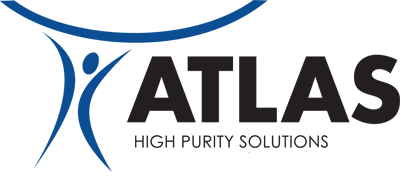Atlas High Purity Solutions provides a summary explanation of ASTM and ISO laboratory water quality standards
High Purity Water (similarly referred to as "RODI Water" or "Ultrapure Water") will have different meanings for different users. Water that is pure enough for the cleaning of laboratory glassware, for example, may be wholly inadequate for use within tissue culturing or pharmaceutical applications.
There are many grades of high purity water and many standards-setting organizations that define them. These standards help end users gain confidence in their water’s purity and its applicability to certain applications. ASTM has long been a prevailing standard in the Greater-Boston laboratory water space, whereas ISO has been more commonly encountered in Europe. Here, we examine the water quality standards set forth by ASTM International and the ISO.
Who are ASTM International and the ISO?
ASTM International – Since 1898, ASTM International has been developing standards worldwide across a wide range of industries. Of the more than 12,000 ASTM standards in-force today, ASTM D1193-06(2018) sets one bar for water quality standards in laboratory-grade water.
The ISO – Like ASTM International, the International Organization for Standardization (ISO) also sets international standards that span a diverse range of industries. Founded in 1947, the ISO has released more than 22,000 international standards, including ISO 3696:1987, which sets the ISO’s definition for its three degrees of water purity.
How do the standards function?
ASTM International and the ISO have both set standards for defining and categorizing water purity in laboratory-grade water. While ASTM International defines water purity using a scale ranging from Types I through IV, the ISO instead uses a scale containing Grades 1 to 3 with Type I/Grade 1 being the highest quality. The ASTM also provides a substandard with different grades for varying levels of microbiological contaminants.
ASTM International - D1193-06(2018)
Standard Specification for Reagent Water


International Organization for Standardization (ISO) – ISO 3696:1987
Specifications for Water for Analytical Laboratory Use

Interpreting the parameters
Understanding each parameter specified by the ASTM or ISO is critical in both establishing and maintaining water quality targets. Below are brief descriptions of each parameter as they pertain to high purity water applications.
Resistivity [ASTM only]
How resistant is this water to electrical current?
Resistivity is the reciprocal of conductivity. If water has a high resistivity, it has a low conductivity, and vice versa. Resistivity is measured in MO-cm (Megohms per centimeter) at 25°C. The maximum resistivity of high purity water is approximately 18.3 megohms. This water is essentially non-conductive and is completely devoid of dissolved cations and anions.
Conductivity [ASTM and ISO]
How great of an electrical current is this water capable of conducting?
Similar to resistivity, conductivity tells us how much dissolved, conductive content the water contains. Conductivity is the reciprocal of resistivity, and is essentially the same metric calculated conversely. Therefore, if water is highly conductive, it is not highly resistive. Conductivity is measured in µS/cm (microSiemens per centimeter) at 25°C. In high purity water applications, maximum resistivity (minimal conductivity) exists in a vacuum, as highly resistive water is inherently unstable and will degrade rapidly if exposed to carbon dioxide. As a result, most ultrapure water applications measure resistivity with an inline probe, positioned on the "loop out" and/or "loop return" of a recirculating system.
See our article on deionization for more on resistivity and conductivity.
pH [ASTM and ISO]
How acidic or alkaline is this water?
pH measures the concentration of hydrogen ions in water. A pH above 7.0 indicates water is alkaline; a pH below 7.0 indicates it is acidic. The pH parameter applies only to the least pure water classifications, as ultrapure water does not contain dissolved content to impact its pH.
Total Organic Carbon (TOC) [ASTM only]
How much organic content does this water contain?
Water naturally contains organic compounds. Total organic carbon, commonly abbreviated as TOC, measures the quantity of organic content present in a water source. TOC is measured in in ppb or µg/L. It is a critical contaminant to manage and monitor in many applications including semi-conductor, pharmaceutical grade water, and various healthcare applications as it is a general indication of the level of organics present in a high purity water system. A well-designed high purity water system will include technologies designed to remove, manage and measure TOC, including reverse osmosis (RO), 185 NM UV (often referred to as “TOC Destruct” UV), mixed bed deionization, and online TOC monitoring equipment.
Sodium, Chloride, and Silica [Na and Cl- ASTM only, SiO2 both ASTM & ISO]
How much sodium, chloride or silica is present in this water?
Both the ASTM and ISO standards establish limits for the amounts of silica in laboratory water in ppb or µg/L (ppm in the ISO). The ASTM standard also establishes limits for chlorine and sodium in ppb. Each of these three contaminants are also cations or anions and are therefore reflected in resistivity/conductivity. In practice, a high purity water system generating 18+ megohm resistivity water should have near-zero vales for each of these three dissolved contaminants.
Additional ASTM Sub-Standards
Heterotrophic Bacteria Count
How much bacteria is present in this water?
A water’s heterotrophic bacteria count, measured in CFU/ml, is a relative measure of how much bacteria is in a given feed water source. This is an absolutely critical metric for most laboratory, medical, and pharmaceutical applications as most uses of high purity water in these applications are micro-biologically sensitive.
While the ASTM recognizes the CFU/ml metric (determined by heterotrophic plate counts), this method only measures specific types of bacteria and is therefore only a general indication of the level of bacteria present in a high purity system.
A well-designed high purity water system will minimize the opportunity for bacteria growth by utilizing technologies such as reverse osmosis (RO), 254 NM UV, and absolute sub-micron filtration, while ensuring that loop flow rates generate velocities greater than 3 feet per second. When paired with a properly designed loop (free of dead legs or other inefficiencies) and a proper maintenance regimen, the resulting environment is capable of maintaining ultra-low levels of bacteria.
Endotoxins
How much endotoxin is present in this water?
Endotoxins are byproducts of the bacterial lifecycle. As bacteria progress through life, they release endotoxins, which is a critical contaminant to measure in many high purity water applications. Endotoxins are measured in endotoxin units per ml (EU/ml). Managing endotoxin in high purity water systems goes hand in hand with managing bacteria. However, many of the technologies used to destroy bacteria can actually generate temporary increases in endotoxin. This can be addressed in system design by utilizing the right type of final filtration, and particularly sensitive applications such as dialysis or pharmaceutical grade water should utilize endotoxin rated filters (at the appropriate flow rate per ten-inch equivalent) in the system design.
Additional ISO Parameters
Oxidizable Matter Oxygen Content
How much oxidizable matter is present in this water?
Measured in mg/L, this parameter measures how much oxidizable matter is present in water. It is only relevant to ISO Grade 2 and ISO Grade 3 applications, as Grade 1 applications should be largely free of oxidizable matter.
Absorbance
How absorbent is this water?
This parameter measures water’s ability to absorb light of a specific wavelength. Higher purity (Grade 1) applications have a very low ability to absorb light as they are largely devoid of dissolved content.
Residue after evaporation
If heated to 110 degrees C, how much residue will remain post-evaporation?
This relatively straightforward parameter measures how much residue remains if the water is heated to 110 degrees C and allowed to evaporate.
Questions? Contact Atlas High Purity Solutions
Navigating the various grades and standards for high purity water can be intimidating. Atlas High Purity Solutions designs, installs, and services high purity water systems capable of maintaining each of these given standards. Contact Atlas High Purity Solutions to discuss the performance requirements of your high purity water application.
__
Atlas High Purity Solutions has been designing, installing, and servicing high purity water systems for more than thirty years, and is the leading provider of reverse osmosis and DI water solutions in the northeast United States.



